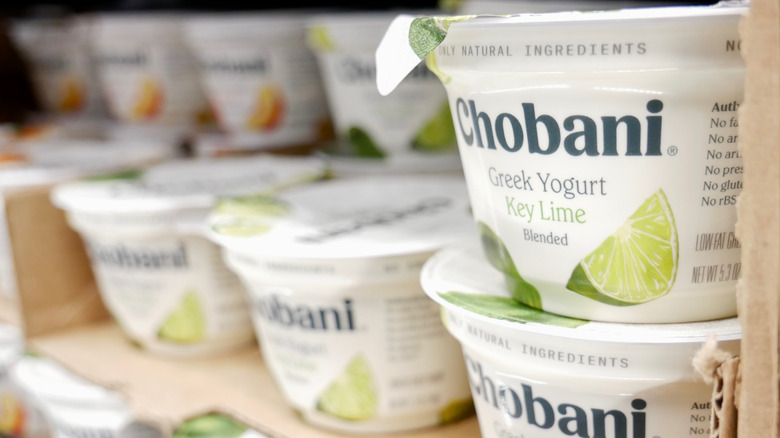The Difference Between Greek Yogurt And Regular Yogurt
After starting as an early 2010s health fad, Greek yogurt enjoyed a meteoric rise in popularity before eventually reaching a global market size of $27.4 billion by 2020, according to a study conducted by Grand View Research. These days, the product has cemented itself as a dairy staple in most grocery stores. But with so many people making the permanent switch from regular yogurt to Greek, it begs the question: What's the difference between Greek and regular yogurt that allegedly makes the former healthier than the latter?
The tricky part is that there isn't anything that actually makes Greek yogurt better for you in quantifiable terms. Greek yogurt has a different nutritional makeup due to being strained and concentrated during the manufacturing process, which also gives it its signature thicker texture. Whether or not Greek yogurt is healthier — and worth the higher price point — is entirely dependent on individual dietary and lifestyle needs, and there are a few key differences at play.
Greek yogurt is thicker and more sour
For the most part, Greek and regular yogurt have the same color, smell, and taste when unflavored: Ever so slightly off-white with that signature sour taste of fermented milk. Greek yogurt may be slightly more sour while regular yogurt is a bit sweeter, but the biggest and most obvious difference comes down to the density. Regular yogurt is similar in consistency to mayonnaise or light pudding. Greek yogurt, on the other hand, is almost halfway to cream cheese in terms of texture — much closer to solid than liquid comparatively.
While both yogurts complement fruits and other sweet flavors equally well, some might find themselves adding much more sweetener to Greek yogurt than regular to fully take the sour edge off of the flavor profile. However, those who enjoy the natural taste of fermented dairy will probably enjoy the concentrated taste of Greek yogurt.
Greek yogurt is made by filtering out the whey
The basic process for making yogurt remains much the same today as when it was first invented in ancient times — all that has really changed is the implementation of modern safety standards. Two beneficial starter cultures, lactobacillus bulgaricus and streptococcus thermophilus, are added to heated milk and left to grow in the warm and nutritious environment. In industrial settings, the starting milk is often a pasteurized mixture of cream and powdered milk. As the bacteria multiplies, it ferments the milk and begins to separate it into yogurt and a liquid layer of whey, similar to how cheese initially separates into cheese curds and whey.
Here is where regular yogurt and Greek yogurt diverge in the manufacturing process. Where regular yogurt has the whey stirred and incorporated back into the product, Greek yogurt is made by straining the liquid out, which creates its thick, concentrated texture. Contrary to its name, this style of strained yogurt isn't exclusive to Greece: History shows that it was a much more popular practice in the Middle East and parts of Eastern Europe.
Greek yogurt is more expensive
While Greek yogurt is notably pricier than the regular kind — sometimes even up to double the price depending on the brand — it's not necessarily because it's healthier or higher quality. By virtue of how it's manufactured, Greek yogurt uses much more milk and cream and is more expensive to produce. What you're paying for is essentially a concentrated dose of extra dairy product in the same-sized carton.
Thankfully, there's a wide variety of brands and price points to choose from due to its explosion in popularity over the past decade. While it was once a niche product, it now comes in almost as many flavors and varieties as regular yogurt alongside other kinds of strained yogurt. It has become popular enough worldwide that you'll probably be able to find imported or domestic brands of Greek yogurt wherever you go. However, if you're traveling abroad to Greece itself, try looking for "straggisto" instead — asking for Greek yogurt will probably get you confused or exasperated looks from the local residents.
Regular yogurt lasts longer and is more versatile
Because of their similar compositions, it's usually feasible to use Greek and regular yogurt interchangeably in recipes. Mixing Greek yogurt with some extra milk to soften the texture yields results comparable to regular yogurt in most cases. However, it's worth noting that Greek yogurt is slightly less acidic than the regular kind, and adding liquid won't change that. The lower acid level probably won't be an issue when making sweet foods like smoothies and parfaits. However, if you're the type to marinate your meat in yogurt, you should probably stick to regular yogurt for more effective tenderization.
Another side effect of the acidity is how long the yogurt can last in the fridge. While all kinds of unopened yogurt are safe to eat past the expiration date, Greek yogurt's grace period is shorter than regular. Your untouched tub of regular yogurt still has a fighting chance for up to three weeks past the expiration date on average, but Greek yogurt only lasts two weeks, maximum.
Both have their own health benefits
Whether Greek or regular yogurt is healthier comes down to your individual needs. Greek yogurt has lower lactose, more calories and saturated fat, half the carbs and sugar, double the protein, and less calcium. At a glance, it seems that Greek yogurt is overall better for people who might be slightly lactose intolerant or want more calories and protein for less carbs and sugar in the same daily portion.
On the other hand, regular yogurt's high calcium and low protein content could be much more suitable in specific cases. For one, experts say that extra protein is unnecessary for infants. With growing children, parents may want to weigh the benefits of the extra calcium in regular yogurt as opposed to what Greek yogurt has to offer. People suffering from or at risk of kidney and heart disease should also be wary of excess protein intake and could benefit more from regular yogurt instead.





